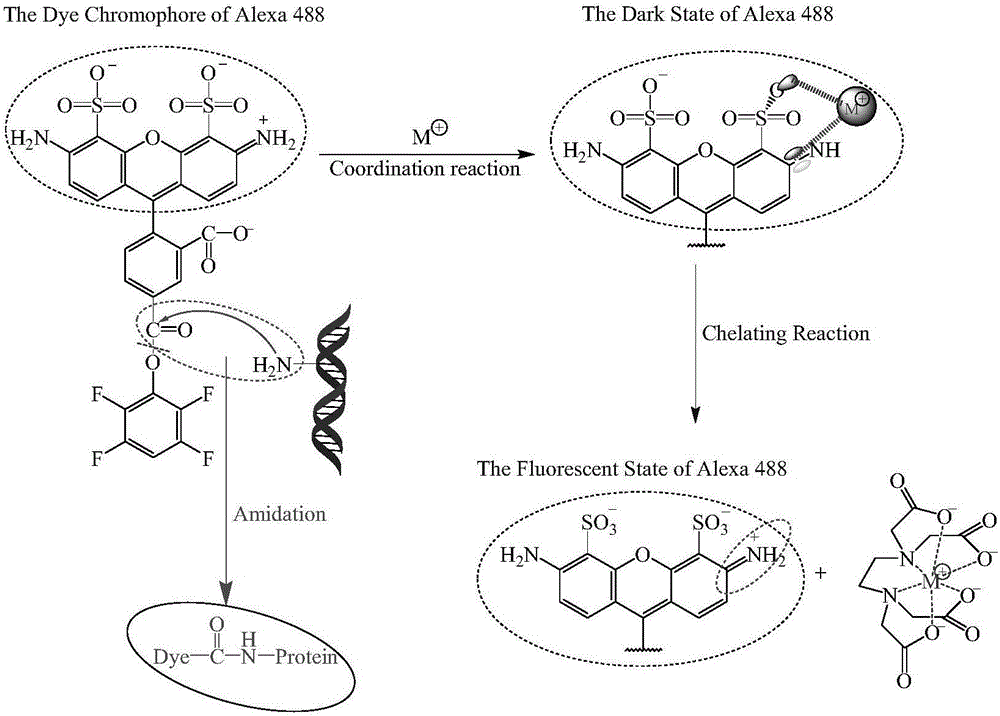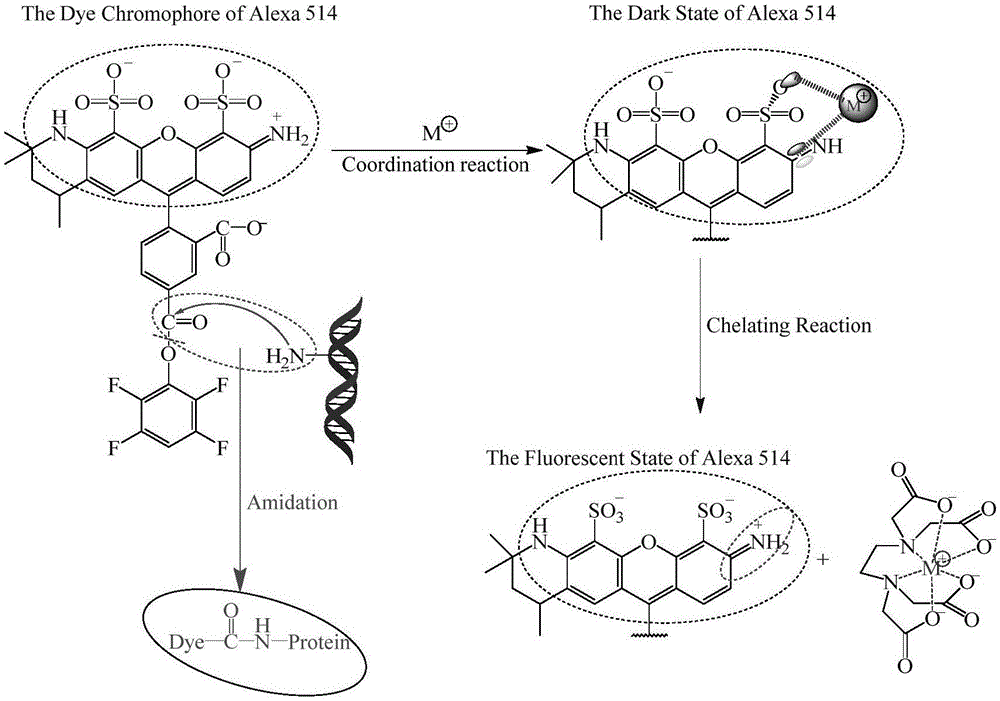Fluorescence control method used in labeling biological tissues with organic fluorescent dye molecules
A technology of fluorescent dyes and control methods, which is applied in the field of fluorescence control of organic fluorescent dye molecularly labeled biological tissues, can solve the problems of reducing the conjugated π electron density of organic fluorescent molecules, the difficulty of accurate three-dimensional registration, and the interference of imaging background fluorescence, etc., to achieve Suppression of interference from background fluorescence, reversible quenching, and convenient reactivation
- Summary
- Abstract
- Description
- Claims
- Application Information
AI Technical Summary
Problems solved by technology
Method used
Image
Examples
Embodiment 1
[0053] (1) Fix the perfused mouse brain with 4% PFA solution and rinse with PBS solution;
[0054] (2) Immunohistochemically label the fixed and rinsed 100-micron mouse brain tissue slices with Alexa 488 and rinse with PBS solution: first, fix the 100-micron slices with 20% DMSO and 0.2% Triton X-100 in PBS solution Punch holes with the rinsed mouse brain tissue slices for 12 hours, then add 10% serum to block for 12 hours, rinse with PBS for 1 hour / 3 times, then add the primary antibody at a ratio of 500:1 at 37°C in the dark Incubate with shaking for 2 days, then incubate with shaking at 37°C for 2 days in the dark, then add the secondary antibody with Alexa 488 at a ratio of 800:1, incubate with shaking for 8 hours at 4°C in the dark, and rinse with PBS for 1 hour / 3 times to obtain Alexa 488 immunohistochemically labeled 100 micron mouse brain tissue slice;
[0055] (3) Soak 100 micron mouse brain tissue slices immunohistochemically labeled with Alexa 488 in 10mmol / L FeSO ...
Embodiment 2
[0059] (1) Fix the perfused mouse brain with 4% PFA solution and rinse with PBS solution;
[0060] (2) Immunohistochemically label the fixed and rinsed 100-micron mouse brain tissue slices with Alexa 488 and rinse with PBS solution: first, fix the 100-micron slices with 20% DMSO and 0.2% Triton X-100 in PBS solution Punch holes with the rinsed mouse brain tissue slices for 12 hours, then add 10% serum to block for 12 hours, rinse with PBS for 1 hour / 3 times, then add the primary antibody at a ratio of 500:1 at 37°C in the dark Incubate with shaking for 2 days, then incubate with shaking at 37°C for 2 days in the dark, then add the secondary antibody with Alexa 488 at a ratio of 800:1, incubate with shaking for 8 hours at 4°C in the dark, and rinse with PBS for 1 hour / 3 times to obtain Alexa 488 immunohistochemically labeled 100 micron mouse brain tissue slice;
[0061] (3) Soak 100 micron mouse brain tissue slices immunohistochemically labeled with Alexa 488 in 100mmol / L FeCl...
Embodiment 3
[0065] (1) The perfused 100-micron mouse brain tissue was fixed with 4% PFA solution and rinsed with PBS solution;
[0066](2) Immunohistochemically label the fixed and rinsed 100-micron mouse brain tissue slices with Alexa 514 and rinse with PBS solution: first, fix the 100-micron slices with 20% DMSO and 0.2% Triton X-100 in PBS solution Punch holes with the rinsed mouse brain tissue slices for 12 hours, then add 10% serum to block for 12 hours, rinse with PBS for 1 hour / 3 times, then add the primary antibody at a ratio of 500:1 at 37°C in the dark Incubate with shaking for 2 days, then incubate with shaking at 37°C for 2 days in the dark, then add the secondary antibody with Alexa 514 at a ratio of 800:1, incubate with shaking at 4°C for 8 hours in the dark, and rinse with PBS for 1 hour / 3 times to obtain Alexa 514 immunohistochemically labeled 100 micron mouse brain tissue slice;
[0067] (3) Use 200mmol / L Fe 2 (SO 4 ) 3 Imaging was performed after the solution was que...
PUM
| Property | Measurement | Unit |
|---|---|---|
| Concentration | aaaaa | aaaaa |
| Concentration | aaaaa | aaaaa |
Abstract
Description
Claims
Application Information
 Login to View More
Login to View More - R&D
- Intellectual Property
- Life Sciences
- Materials
- Tech Scout
- Unparalleled Data Quality
- Higher Quality Content
- 60% Fewer Hallucinations
Browse by: Latest US Patents, China's latest patents, Technical Efficacy Thesaurus, Application Domain, Technology Topic, Popular Technical Reports.
© 2025 PatSnap. All rights reserved.Legal|Privacy policy|Modern Slavery Act Transparency Statement|Sitemap|About US| Contact US: help@patsnap.com



